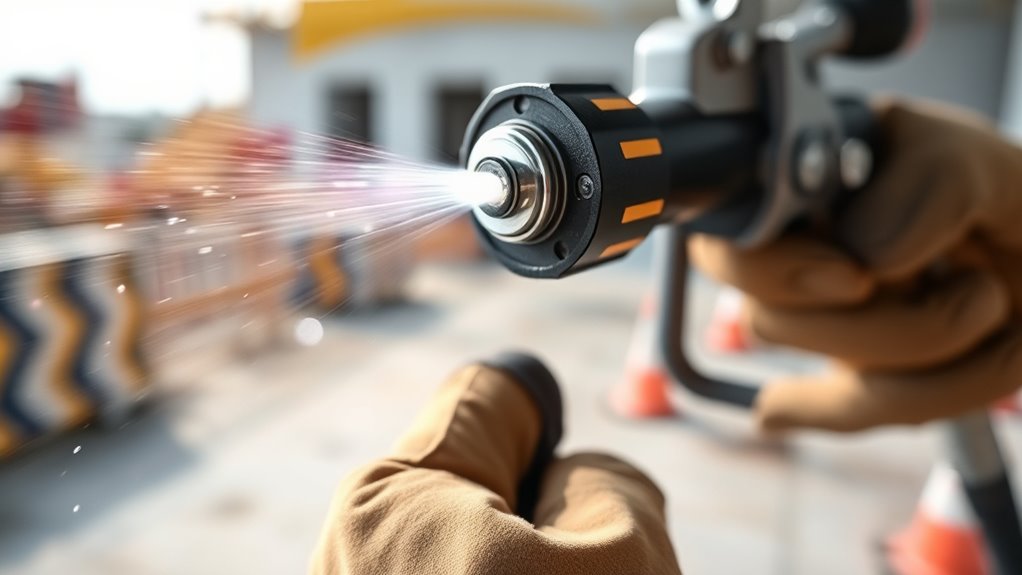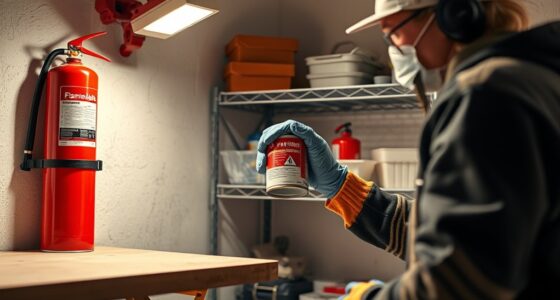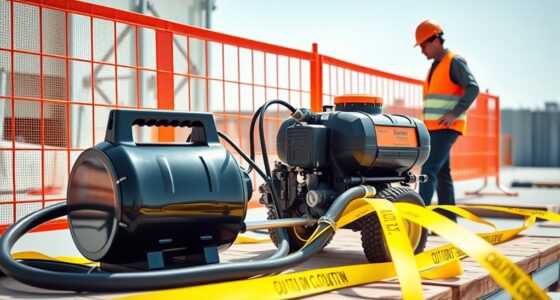Using an airless sprayer exposes you to high-pressure spray injuries that can penetrate your skin and cause serious harm. These equipment parts operate at over 2,000 psi, so accidental contact or equipment malfunctions can lead to injections of the spray into your muscles or tissues. To stay safe, always handle the sprayer with care, wear proper PPE, and follow safety procedures. Keep going to learn more about how to protect yourself from these risks.
Key Takeaways
- Airless sprayers operate at high pressures exceeding 2,000 psi, increasing injection injury risk upon accidental contact.
- Proper training emphasizes safe handling, recognizing hazards, and emergency response to prevent injection injuries.
- Regular equipment inspection and maintenance reduce leaks and sudden high-pressure bursts that can cause injuries.
- Always use personal protective equipment (PPE) to shield skin and eyes from high-pressure spray risks.
- Turning off and depressurizing the sprayer before maintenance minimizes the chance of accidental injection injuries.

Using airless sprayers can pose serious injection injury risks if you’re not careful, even though they make painting projects faster and easier. These tools operate under high pressure, often exceeding 2,000 psi, which means that accidental contact with the spray tip or hose can lead to severe injuries. To protect yourself, proper safety training is essential. Safety training helps you understand how to handle the equipment correctly, recognize potential hazards, and respond effectively if an accident occurs. Without this knowledge, you might underestimate the dangers or mishandle the sprayer, increasing the risk of injection injuries that can cause tissue damage, nerve injury, or even require surgery.
Equipment maintenance plays a vital role in preventing accidents. Regularly inspecting your airless sprayer ensures that all parts are in good working condition, especially the spray tip, hoses, and pressure controls. Worn or damaged components can cause leaks or sudden bursts of high-pressure spray, which might result in injection injuries if they come into contact with your skin. Cleaning and maintaining your equipment after each use prevents blockages and ensures consistent operation, reducing the chance of malfunctions that could lead to accidents. Additionally, proper maintenance involves relieving pressure from the system before cleaning or servicing, which is a fundamental safety step often overlooked.
You should always wear the appropriate personal protective equipment (PPE), including gloves, safety glasses, and long-sleeved clothing, to minimize skin exposure. Even with safety training and meticulous maintenance, accidents can happen if you’re not cautious. Never point the spray at yourself or others, and keep your hands away from the spray tip during operation. When adjusting or cleaning the equipment, always turn off the sprayer and depressurize the system to prevent unexpected spray or high-pressure release. Remember, safety training isn’t just about knowing how to operate the sprayer but also about understanding how to troubleshoot and maintain it properly.
Frequently Asked Questions
How Often Should Airless Sprayer Equipment Be Inspected for Safety?
You should inspect your airless sprayer equipment regularly, ideally following the maintenance schedules recommended by the manufacturer. Check safety features, hoses, and connections at least every 1 to 3 months, or after heavy use. Also, verify proper equipment calibration before each project to prevent injection injury risks. Regular inspections help spot potential issues early, keeping you safe and ensuring the sprayer operates efficiently.
What Are the Long-Term Health Effects of Injection Injuries?
Injection injuries can lead to long-term health effects like chronic nerve damage and persistent tissue scarring. If untreated, you might experience ongoing pain, numbness, or weakness, which can impair daily activities. The tissue damage may become permanent, requiring extensive medical intervention. To prevent these serious outcomes, always seek prompt medical attention if injured, and follow safety protocols when using airless sprayers.
Are There Specific Protective Gear Recommendations for Different Spraying Tasks?
Picture yourself as a shield-bearer, ready for battle. For spray tasks, you need protective gear tailored to each mission. When working with high-pressure airless sprayers, wear gloves, goggles, and respirators for safety. For detail work, opt for masks and coveralls. Always select task-specific protective gear to prevent injection injuries and exposure. Your gear acts as your armor, ensuring safety in every spray operation you undertake.
How Quickly Should Medical Treatment Be Sought After an Injection Injury?
You should seek emergency response and medical treatment immediately after an injection injury. Prompt treatment timing is vital to prevent serious tissue damage or infection. Don’t delay or try to treat it yourself; go to the emergency room right away. Quick action ensures proper assessment, possible intervention, and better recovery outcomes. Remember, early medical attention can make a significant difference in managing injection injuries effectively.
Can Training Reduce the Risk of Injection Injuries During Spraying?
Like a carefully guided compass, proper training can substantially reduce your risk of injection injuries during spraying. When you focus on safety awareness and learn correct techniques, you’re better equipped to handle equipment safely and recognize hazards early. This proactive approach minimizes accidents, ensuring your safety on the job. So, investing in thorough training isn’t just smart—it’s essential to prevent injuries and work confidently with airless sprayers.
Conclusion
So, next time you reach for that airless sprayer, remember: a tiny slip could turn you into a living sculpture—permanently inked with an injection injury. Who knew that a tool designed to make your job easier could double as a high-tech tattoo machine? Stay vigilant, wear your safety gear, and maybe, just maybe, avoid turning your skin into a modern art installation. After all, beauty is pain, but avoid unnecessary piercings.










